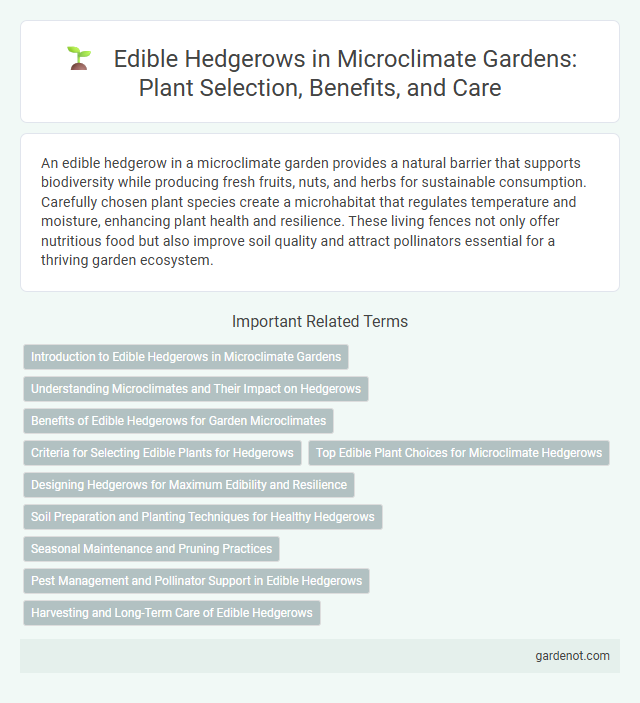An edible hedgerow in a microclimate garden provides a natural barrier that supports biodiversity while producing fresh fruits, nuts, and herbs for sustainable consumption. Carefully chosen plant species create a microhabitat that regulates temperature and moisture, enhancing plant health and resilience. These living fences not only offer nutritious food but also improve soil quality and attract pollinators essential for a thriving garden ecosystem.
Introduction to Edible Hedgerows in Microclimate Gardens
Edible hedgerows in microclimate gardens serve as multifunctional borders that enhance biodiversity while providing fresh fruits, nuts, and herbs. These plantings optimize space by combining windbreaks, habitat creation, and food production, adapting to localized climate conditions to improve growth and yield. Incorporating species like currants, hazelnuts, and aromatic herbs can create resilient, sustainable garden ecosystems that support both wildlife and human nourishment.
Understanding Microclimates and Their Impact on Hedgerows
Edible hedgerows shape microclimates by influencing wind patterns, soil moisture, and sunlight exposure, creating favorable conditions for diverse plant growth. Understanding microclimates helps optimize species selection and planting arrangements to enhance fruit and vegetable yields in edible hedges. Strategic placement of hedgerows improves microclimate stability, supporting healthy ecosystems and sustainable food production.
Benefits of Edible Hedgerows for Garden Microclimates
Edible hedgerows enhance garden microclimates by providing natural windbreaks that reduce soil erosion and moisture loss, promoting healthier plant growth. They support biodiversity by attracting pollinators and beneficial insects, which improves pollination rates and pest control. Nutrient cycling is boosted as leaf litter and root systems enrich the soil, fostering a resilient and productive garden ecosystem.
Criteria for Selecting Edible Plants for Hedgerows
Choosing edible plants for hedgerows requires evaluating factors such as climate adaptability, soil compatibility, and growth habits to ensure sustainable development. Plants with high nutritional value, pest resistance, and ease of maintenance enhance the productivity and longevity of the edible hedge row. Incorporating diverse species like berries, herbs, and nut-producing shrubs promotes ecological balance and maximizes yield in microclimate garden settings.
Top Edible Plant Choices for Microclimate Hedgerows
Top edible plant choices for microclimate hedgerows include bay laurel, rosemary, and sage, which thrive in sheltered conditions and provide year-round harvests. Fruit-bearing options like blackberries, gooseberries, and currants offer high yields while enhancing biodiversity and supporting beneficial insects. Incorporating nitrogen-fixing plants such as autumn olive improves soil fertility, promoting overall hedge health and productivity.
Designing Hedgerows for Maximum Edibility and Resilience
Designing hedgerows for maximum edibility and resilience involves selecting a diverse mix of fruit-bearing shrubs, nut trees, and perennial vegetables that thrive in local microclimate conditions. Incorporating species such as currants, elderberries, hazelnuts, and perennial herbs enhances both food production and habitat stability while improving soil health and moisture retention. Strategic layering and seasonal staggered harvests increase yield and ensure a continuous supply of nutritious produce throughout the year.
Soil Preparation and Planting Techniques for Healthy Hedgerows
Soil preparation for edible hedgerows involves deep tilling and enriching the soil with organic compost to ensure nutrient availability and improved drainage. Selecting nitrogen-fixing plants like legumes supports soil fertility and promotes healthy growth for surrounding crops. Proper planting techniques include spacing plants according to their mature size and layering species with complementary root depths to maximize water and nutrient uptake in the microclimate garden.
Seasonal Maintenance and Pruning Practices
Edible hedgerows require seasonal maintenance to ensure robust growth and productivity, with pruning practices timed to remove dead or overcrowded branches during late winter or early spring. Regular pruning promotes airflow, reduces disease risk, and encourages fruit or foliage development. Applying mulch and monitoring soil moisture throughout the growing season supports plant health and optimizes yields.
Pest Management and Pollinator Support in Edible Hedgerows
Edible hedgerows enhance pest management by attracting beneficial insects such as ladybugs and predatory wasps that naturally control pests, reducing the need for chemical interventions. These diverse plantings support pollinators like bees and butterflies, crucial for increasing fruit set and overall yield in adjacent crops. Integrating native flowering species within edible hedgerows further strengthens ecological balance and promotes resilient microclimate conditions for sustainable garden productivity.
Harvesting and Long-Term Care of Edible Hedgerows
Harvesting edible hedgerows requires careful timing to ensure fruits and vegetables reach peak ripeness, enhancing flavor and nutritional value. Regular pruning promotes healthy growth and prevents overcrowding, supporting long-term productivity and pest resistance. Applying organic mulch and seasonal compost boosts soil fertility, sustaining the hedgerow's vitality across years.
Edible hedge row Infographic

 gardenot.com
gardenot.com